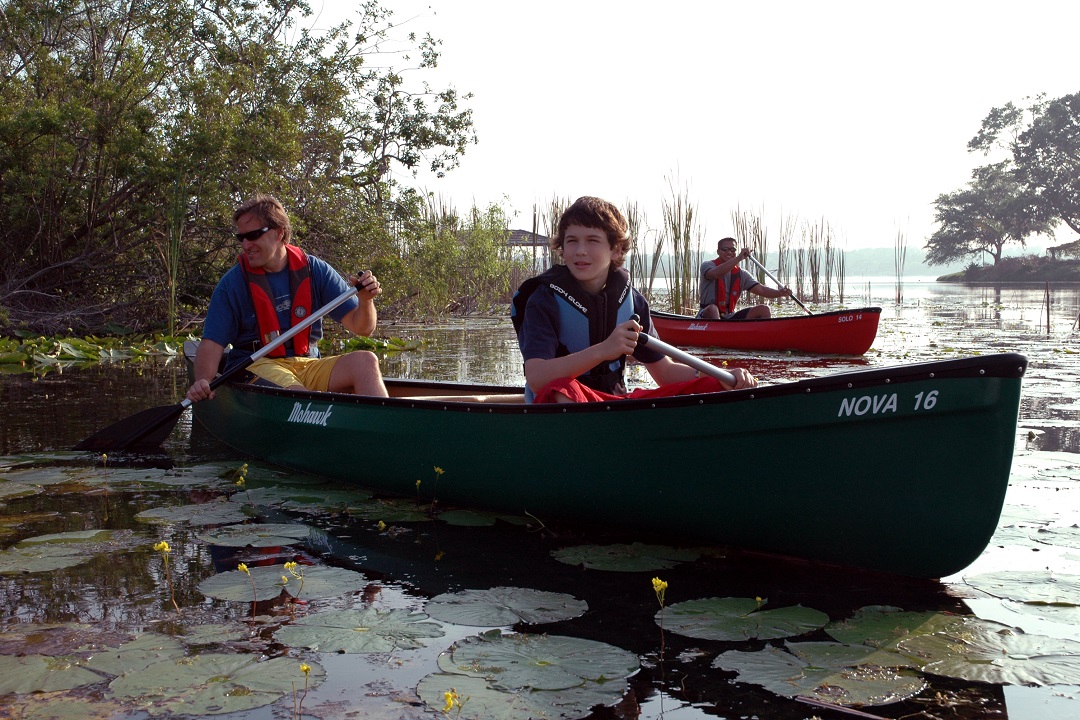To the novice paddler, deciding which sport to try can be confusing. Sure, canoeing, kayaking, and stand-up paddleboarding (SUP) all employ spoon-shaped paddles that allow users to push water toward the back of the craft and provide forward propulsion, but the similarities pretty much end there.
Each of these three popular Midwest activities has its own merits and capabilities, even its own attitude. We consulted a local expert in each of the aforementioned sports and picked his or her brain about what makes their preferred pastime unique, then asked from some tips to accelerate the learning curve. Here’s what we learned.
Canoeing
Fiona Fordyce is lead canoe guide for Big Muddy Adventures and has years of experience plying the St. Louis area’s iconic rivers. “Canoeing is great because anyone can do it, from little kids to those later in life,” she said. Fordyce is drawn to the simplicity of canoeing, along with the hauling capabilities of the vessel. “It’s easy to throw a tent, a cooler, a few chairs — whatever you need — into a canoe and set out for an exceptional camping experience,” she said.
While you can whitewater canoe, flatwater canoeing is the norm and generally appeals to those seeking a quiet, peaceful outing on a lake or river. Because they have seats and you can adjust your body position, canoes are generally more comfortable, especially for longer distances. Canoeing can be more social than other paddle sports, too, since multiple people can fit into a single boat.
A canoe is arguably the most stable craft discussed here, but also the most likely to sink if flipped over or “swamped”. Canoes are usually larger and can be more difficult to transport, and can be harder to steer in a straight line until the person in the stern (who maneuvers the boat) has mastered the basic paddle strokes. But these are quickly learned.
Kayaking
Maria Crusius is a whitewater kayak instructor and long-time member of the Missouri Whitewater Association. “I like kayaking because I don’t have to share control of the boat. I can go where I want, when I want, and do what I want,” she said.

Kayaking allows independent freedom. (Big Muddy Adventures)
Kayaks are extremely versatile — as well as light and easy to transport — allowing them to get to places where a typical canoe can’t go. Kayaks also take less effort to propel, go faster, and handle whitewater better. The sport often appeals to thrill-seekers as well as those who want to be “one with the boat”. Feet, knees, and hips are often used to maneuver the boat in addition to paddle techniques (double-bladed paddles help with efficiency and control).
It’s unlikely you’ll come away from a kayaking session completely dry, which can be viewed as a pro or con. “I’m able to roll my boat if I want to cool off, which is nice,” said Crusius, noting that only whitewater kayaks are designed to perform the move.
There are countless varieties of kayaks — sea kayaks, sit-on-top kayaks, whitewater kayaks — each differing greatly. It’s quick and easy to learn the basics, though, and more specialization means more options to pursue down the road.
Stand-up Paddleboarding
Shane Perrin is owner of SUP St. Louis and has been leading local clinics since 2012. “SUPing is different in that you’re literally standing on water,” he said. “It’s a totally unique perspective. It appeals to experienced canoers and kayakers that are looking for something new.”

Stand-up paddleboarding provides a unique, full-body workout. (Boathouse Paddle Co.)
It’s hard to beat the vantage point that a SUP allows, both above the waterline and below — in an area with clear conditions, you can spot fish and other underwater features. The portability of a SUP is also appealing, along with the activity being a low-impact, full-body workout that engages not just your arms and shoulders but also your core and legs.
Sitting is more stable than standing, which might be a concern for longer outings. (Of course, you can always just sit down if you get tired.) On the other hand, there’s an undeniable “cool factor” that comes with being noticed while standing in the middle of lake or river.
There are SUPs designed for flatwater as well as for surfing and touring, allowing some personalization based on use. It’s even possible to bring a child or dog with you on larger models, something you can’t do with a kayak.
So, there you have it. The only question that remains is which paddle sport is right for you?
Expert Tips
Canoeing
“Don’t rock the boat, it’s as easy as that,” said Fordyce. “Keep your balance centered over the canoe, and the boat will stay steady. When paddling, keep the paddle vertical and use the entire length of the blade’s surface. Otherwise, you’re wasting energy.”
Kayaking
“The wrong boat for the wrong water could spell trouble,” said Crusius. “Know what kind of kayak you’re using, what it’s capable of, and the body of water you’re paddling. Practice your self-rescue techniques in a safe, controlled environment before setting out, so you’ll be prepared.”
Stand-up Paddleboarding
“Take a deep breath and relax,” Perrin said. “SUPing requires a loose body: bend your knees, bend at your hips, look at a point on the shore and relax. Also, don’t be afraid to fall in. That’s part of the fun!”
Author: Nick Tilley is a regular contributor to Terrain Magazine.


Leave A Comment